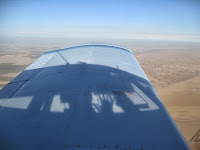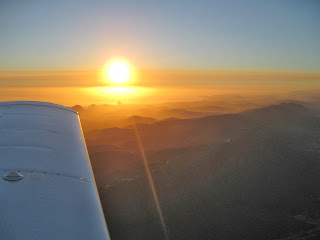 |
| This is it! - we hope. |
But with the latest development, I had a choice: have Rick, my examiner,
come back up to Auburn the following week and pay him the full retest fee—or
accept his offer for a generous discount if I would fly myself over to his home
airport in Cameron Park... So much for staying local. I picked the obvious
choice.
Probably the worst thing about discontinuing the
test was coming back home and bumping into all my friends who were very excited to know the results. Thankfully the week went by quickly,
and pretty soon I was staring down my checkride day again. I got word that the
plane was back in service, so I went out for a good long session, practicing
the navigation, landings, high work, and familiarizing myself with the area around Cameron Park.
The landing gear was working flawlessly. That wasn’t the
only thing Bob had fixed. Apparently the pilot’s seat had been sagging, so he
straightened that problem out. Of course, I hadn’t even noticed the seat was
broken—until it was fixed. I wished he would have done that after my checkride.
Everything seemed to stay together as I headed back to Auburn. It was a bit
disconcerting to have some small birds appear in front of the plane and flash
past the window. They managed to make it out of the way and a few moments later I touched down with
a plane that was as flaw-free as any 44 year-old plane can be. Next flight on the
schedule: a hop down Cameron Park the next morning to see Rick again.
Since we were meeting at noon, I didn’t have to be up hours
before dawn getting ready. I was enjoying my leisurely morning a bit too much, however, and I found myself scrambling at the last minute plugging in newly
adjusted headings in my navlog. Finally getting it all together, I headed out
the door, hoping that this time I would return with a brand-new
Temporary Airman Certificate.
 |
| Bad attitude. Ok, that's an old joke. Wasn't funny at the time. |
The flight to Cameron Park in the Arrow was short, barely 12
minutes long. I was thrilled when I took off to find the attitude indicator (artificial horizon) all out of whack, indicating a 60-degree bank while in straight-and-level flight. Just the day it would decide to break. Since it's not a required instrument for VFR flight, I got out a sticky note and pasted "Inop" over the dial's face. Halfway through the brief flight, the instrument mysteriously revived.
Entering the pattern, I decided to do warm up for the day by
arriving with a short-field landing. As I descended down final I could see a
figure standing in the transient parking, watching. I flared…and floated,
finally settling down with a thud beyond my aiming point. So much for that.
Rick was the person waiting in the parking area. We went inside the
local maintenance hangar’s office and did the online paperwork. We were both
grateful the government shutdown had just ended, because that meant the bugs
with IACRA (the FAA’s online certification website) had been fixed. No oral to
do today; it was just a short briefing from Rick on what the “plan of action”
for the flight was, and then back to the plane to go do it.
First up on the to-do list after taking off was cross-country navigation. I
picked up a course from Cameron Park that followed Highway 50 toward South Lake Tahoe. The VOR
at Placerville
gave me the opportunity to demonstrate my ability to use electronic navigation,
and the pilotage and dead reckoning also worked out quite well. It helps when
your checkpoints aren’t 50 miles apart.
After about ten minutes it was time to move on to the
next part of the scenario. “Okay Michael, let’s say we don’t like the look of
the weather up ahead and I hear they make some good hot chocolate down at
Rancho Murieta. Take me there.” Righto, time to demonstrate diversions. Do some quick plotting
and calculations, turn to the new heading, and advise the examiner of the ETA.
A few minutes later, bingo! Right over
the field, right on time.
 |
| Demonstrating lazy-eights between other no-so-lazy tasks. |
Maneuvers were next. Steep turns, lazy eights, slow flight,
power off stalls, power on stalls, accelerated stalls (did I mention stalls?). The next part was fun: a simulated engine fire, necessitating a rapid
descent. That led to the next emergency procedure of demonstrating an approach to landing in a field of my choice. Eights-on-pylons rounded off the maneuvers and then it
was time to start on landings back at Rancho Murieta.
Somehow a “normal” landing doesn’t always come off as well
for me as some of the other, more technical landing techniques. In this case a
bit of crosswind combined with a tense hand on the yoke resulted in a touchdown left of centerline. I was more concerned with setting down in the mandatory 200-ft
window, so I wasn’t even thinking about the centerline until I heard Rick’s
voice in my headset. “Michael, see
those white lines? We’re supposed to be over there.” I stiffened, and got on
the rudder pedals to realign the plane in the middle of the runway.
A soft-field take-off and landing followed. Touchdown seemed a bit squirrelly, but I met the main objective of holding the nose wheel off the ground as long as possible. Needless to say, I was also quite concentrated on that centerline.
Returning to the beginning of the runway we took off again for the most dreaded
maneuver of the commercial checkride: the power-off 180 degree accuracy
landing.
“This is it. Remember, you have one shot at this. Show me you can put the plane down on the mark.” Though I was well aware of the high stakes, I didn’t find this
maneuver that intimidating. Maybe I should have. I think I was just dreading
the short-field landing back at Cameron Park more than this.
All set up on downwind, I pulled the throttle back and
started my arcing turn for the runway, making sure to focus on my aiming point.
Right away I realized the lower-than-usual traffic pattern altitude had thrown me a curve ball and I was already getting too low. Time to pull back the blue knob. Trees
and buildings were passing rather closely below the plane now as I continued
making a beeline for the tarmac. I could see Rick start to stiffen up out of
the corner of my eye. As I steepened the bank a couple hundred feet above the
ground to line up with the runway, I wondered if he was going to call the game
for my rather low maneuvering. But no, on we sailed, now with the aiming point
definitely within reach.
Prop control forward, full flaps, bring it in. Start to
flare…oh, we’re going to float. I pulled out my last trick, reaching down and
smoothly lowering the flap handle to the floor. The flaps retracted, dumping
lift from the wings, and we settled firmly onto the runway inside the 200-ft
window. And dead on centerline.
Now for that last landing. I powered up the plane, took off,
and headed back to Cameron Park. Rick directed me on the specifics of how
locals fly the traffic pattern so as to airport neighbors happy. “Make a dogleg from base to final here. We don’t fly over
that person’s house because they tend to get upset and call the airport
manager,” he said, pointing at a building on the ridge to our right.
I was on final now, looking at the runway beyond a very long
displaced threshold. I was a bit high and a bit fast. Not good things. I pulled
power and got back on what looked like a good glide-path. The runway loomed. I
flared. And ballooned.
The plane came back down, hitting the main gears rather
solidly, but I couldn't tell if I had landed within the prescribed window. Somewhat distracted as I wondered where I had touched down I was late
on the brakes, and then completely forgot to retract the flaps to maximize braking
effectiveness (although it’s not a requirement). I felt very warm and
uncomfortable as I taxied back to the parking ramp.
I shut the engine down and Rick asked me about what to do
post-flight. He mentioned a pilot he knew who lost his job because he failed to check the business jet after
landing. When he returned the next day to fly the boss, they saw the plane
had actually been damaged in flight by a bird strike. What could have been
fixed overnight resulted in the boss being late and the pilot getting
fired.
We pushed the plane into its parking spot as he continued to
share little snippets of information. Then, almost as a forgotten gesture, he
stuck out his hand and grasped mine in a quick a handshake. “Oh,
congratulations, by the way,” he interjected. I felt slightly weak. I almost
didn’t dare to believe it. I had passed.
Debriefing back in the office was helpful. He went over the
stronger and the weaker points of the flight, and then managed to wrangle IACRA
into producing a printable certificate. Finally, there it was in black and white:
Temporary Airman Certificate, Commercial Pilot, issued October 17, 2013.
 |
| I think this picture says it best. |
I managed to get a quick snapshot with Rick and my
certificate back out at the plane before we said goodbye and went our separate
ways. I climbed into the Arrow and slowly began setting up the cockpit for the return flight. I
took my time, trying to process the past hour and a half. My brain felt
completely saturated; somehow this felt like the toughest test yet. But by the
grace of God I had passed. One thin piece of paper. One huge milestone in the
path to the mission field. One sweaty commercial pilot.
 |
| Amazing what we'll go through for something from an inkjet printer. |


































